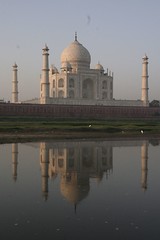Return to Rajasthan
Leaving Uttar Pradesh and re-entering Rajasthan is like going to a different country. Suddenly, the overpopulation seems to fade; people have far more time; the scenery changes towards desert, yet the area appears more agricultural; the roads (and perhaps to a lesser extent, the driving) improve; and the local dress changes. Here, local people are even more colourful than in UP or the north of India. It is not only Sikh men and those in the tourist game who wear turbans: in some areas almost all the men wear turbans, the different styles and colours denoting their historical roots. The women, too, dress differently: more voluminous saris in bright primary colours; chains joining their nose piercing to their ear piercing; thick, solid, silver ankle bands and toe rings to denote married status; and bangles not just on the wrists but all the way from the shoulder downwards. The randomly roaming cows, vast quantities of litter and poverty are still here, but they are diluted down.
After a very long two and a half day drive from Varanasi, we were relieved to arrive in Pushkar. The town is set around a holy lake with lots of bathing ghats around the water’s edge. Despite being there for several days, there were still too many temples in the town for us to be able to count them all. Pushkar’s holy status is somewhat diluted by the number of traveller types who are attracted to it: sunset at the lake draws a crowd of 50 or so every day and is accompanied by drum banging and some very hippified dancing – including a few people who have evidently been here far too long. Surprisingly it has also become a bit of a Jewish hang-out: apparently Pushkar is the place to come and chill out after completing your Israeli military service. So, oddly for the middle of India, there are several Israeli restaurants, signs in Hebrew and even Hebrew overlays on the keyboards in the internet café. Despite the traveller vibe (or perhaps because of it…. though we don’t like to admit that), we really enjoyed our stay in Pushkar and we ended up staying for much longer than we had expected. It is definitely a great place to laze around, watch sunsets over a really pretty lake, do some souvenir shopping (something that we have steered clear of for much of the trip) and eat some really good food (cafes that serve proper toast and proper coffee… hurrah!).
From Pushkar we drove on to Jodhpur, origin of the riding trousers of the same name but also, more interestingly, of an amazing fort. The red sandstone fort towers over the town below and looks really impressive as you drive into town. We found a small haveli where we could stay in the van and eat food in their shaded courtyard (served by women as well as men, which is still a real novelty around here). From there we braved the desert heat to venture out to the fort, which we found to be incredibly well looked after and very interesting. We watched the sun set over the fort and the town from a rocky headland near to one of the many temples and got the bonus of lots of fireworks, as it was an important Hindu festival (although Indian fireworks are rather too orientated towards loud bangs rather than pretty lights for our liking, so it felt akin to observing warfare). Dinner was at a restaurant on the rooftop of the fort next to the cannons: an atmospheric location, lit by candles, in which we enjoyed our vegetarian Rajasthani thalis.
Our next stop was Jaisalmer, right in the middle of the Great Thar Desert. The desert itself is, as you would expect, very arid and incredibly hot but still really colourful, with women carrying terracotta water vessels along the roadside and baskets of crops on their heads. Jaisalmer’s fort is even bigger than the one at Jodhpur and is built of sandstone which has a yellow hue. The fort is surrounded by 99 round battlements (according to the locals at least – Michael pedantically tried to count them but could only find about 60), which make the complex resemble an enormous sandcastle. The rumour doing the rounds it that the whole thing is crumbling away in places (mainly due to water erosion) and it is on the worldwide list of threatened monuments. Inside, the fort is far more like a town than a palace, being made up of lots of inter-twined alleyways, a palace, houses, shops and restaurants. Oh, and an open sewer system, which it is fair to say adds to the “atmosphere”, particularly in the heat. From the fort battlements you can look out towards Pakistan, about 100km away to the west (there is a huge army presence here to guard the border and react in case of heightened hostilities). The highlight of the fort is the Jain temple complex, which contains a series of separate temples, all in intricately carved stone with lots of beautiful arches and figures adorning the walls. The roofs are low and the corridors dark, which lends a strange, slightly Gothic, air to the whole place.
So we have spent the last couple of days wandering around the fort and the town, plus taking a 45km drive out to visit the nearby sand dunes. Here we were able to romp around in the sand and marvel at the number of rich Indian tourists who make it out here – all trying to land the money shot of a sunset camel photo. We have also really enjoyed relaxing at Fifu's Guest House, outside which we have parked the van. It is just outside the town, beautifully decorated and has a fantastic roof terrace with big stone seats covered in cushions - perfect for lazing, supping a few Kingfishers and looking at the picture postcard view of the fort on the horizon.



